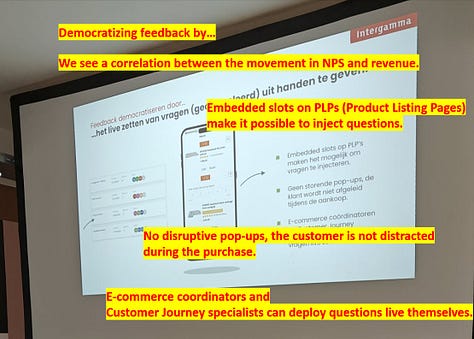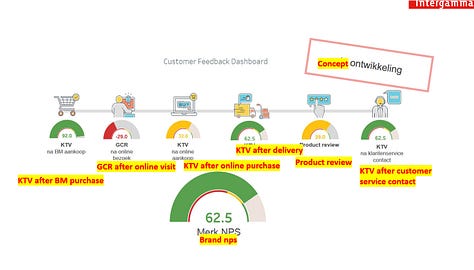Global Digital Marketing & Retail by Alex 63
Inspiration from across the world for retail enthusiasts, e-commerce professionals, marketing lovers and technology fans. Welcome back! I summarized some great links again, I stumbled upon this week.
🇳🇱 Mopinion Connects: the key to understanding your users
So again I went to an event, and again it was a good one. This time it was at the office of Mopinion in Rotterdam, Mopinion is a company that specializes in user feedback analytics, helping businesses collect and analyze real-time customer feedback across digital channels to improve their user experience and optimize conversions.
As always I share a couple of slides and summarize it in bullets. If you need more information just ask me.









The main speakers were from an insurance company called Interpolis and a company named Intergamma, which is a leading omnichannel retailer in the DIY market. Intergamma operates both online and through its well-known brick-and-mortar stores, offering customers a seamless experience across digital and physical channels.
Both talks were about user feedback. The Interpolis talk started with their pyramid, featuring customer and market research. I’ve translated it, and you can see it in the gallery.
One of the challenges Interpolis faces is the declining response rate. For email surveys, their response rate is sometimes as low as 3 percent or less. I think this makes sense—these email surveys are simply outdated. I believe much more in micro-surveys delivered at the right time and place. Interpolis mentioned that they tested adding an employee's face to the survey, which slightly improved the response rate. They’re also going to experiment with using WhatsApp for surveys.
They also do neuro research, but I get back on that later its worth a seperate topic.
Interpolis talked about conversational research—it makes sense, right? Using a chatbot to have a real conversation. They use a company specifically for this purpose. They use this company to do exactly that.
An interesting insight: they regularly record videos of customers who have switched to a competitor, where the customer explains their reasons. These videos even make their way to the board, making the feedback more tangible and fostering a customer-first culture.
The presentation on CRO at Intergamma was really insightful. While I'm familiar with the concept of CRO, what stood out—and what many companies often overlook—is the importance of leveraging user feedback beyond just A/B testing. Gathering detailed user feedback provides a deeper understanding of their needs and behaviors, which is crucial for effective CRO. This feedback can be used not only to optimize individual tests but also to design more meaningful A/B tests from the start, enhancing both the strategy and outcomes of conversion optimization efforts.
The presentation was titled "Democratizing Customer Feedback" and focused on embedding customer feedback within the organization. The goal was to ensure that not every survey or feedback form needs to pass through a single department or individual for approval before it can be implemented. Instead, product owners (or others) from different parts of the site can manage this themselves—they can conduct research and set up their own surveys, with templates provided for support. I really like this approach; I hate bureaucracy and hierarchy. I believe everyone should be empowered to get things done. It doesn't matter who does it, as long as there's collaboration and tangible outcomes.
Intergamma uses Mopinion's tools to gather feedback on specific parts of the website—like validating if the filter options are working well for users. Instead of relying solely on Google Analytics data, they incorporate much more qualitative insights. I really liked this approach. I firmly believe in it, as it means they are constantly improving and gaining a deeper understanding of their users each time.
Intergamma found a correlation between NPS and the following year's turnover, so NPS has now become one of their key metrics. More importantly, they actually act on it—something that doesn't always happen in many companies.
Intergamma also connects all customer feedback and use this information to inform their category managers—like feedback on search filters, which can often guide sourcing decisions. Additionally, they link video recordings to customer feedback, allowing them to resolve bugs more efficiently.
Intergamma is building a customer feedback dashboard, and it reminds me of the passenger experience dashboard from Transavia Airlines that I saw years ago. I think it's a great idea—measuring customer sentiment at different stages of the journey.
The last slide showed a CRO test they conducted in the shopping cart, using a feedback form. They chose to keep the form, but made it less visible, even though it had a slight negative impact on conversion. The reason is that the feedback they gather is more valuable in the long run.
This one is really interesting: for their out-of-home advertising, they now use AI analysis instead of relying on real humans. They use a service called Junbi AI by Alpha.One for this. It looks like it can also be used for YouTube analysis and even “in store” analysis. Definitely something I'd like to try out sometime!





The complete slide deck can be found here, but it’s in Dutch: https://go.mopinion.com/l/287092/2024-10-18/3bg955/287092/1729238625s9rzuDys/Mopinion_Connects_2024_Presentations.pdf
📖Case study: Shopify app user experience and Wix error messages


I always like to read on best practices, real world examples. So I bought the book: “Success At Scale” from the -by the way great site/community- smashing.
Here 2 chapters (see PDF link below for direct download), that I think are inspiring. Do buy the book if it seems interesting to you. The image in the gallery only gives the summary, the PDF below the complete chapter.
In the PDF the case study of Shopify is something to copy. They predict a users needs and instead of waiting for an explicit request to start loading elements, it anticipates what the user might do next based on their actions—like hovering, scrolling, or common navigation patterns. For example, if a merchant hovers over the "Select image" button, the app starts loading the <ImagePicker /> in the background, so everything is ready when they click. This smart behavior makes the experience smoother and faster. Also I liked the way how Wix improves error messages and setup a process for that. All in the PDF, check it out.
Buy the complete book here: https://www.smashingmagazine.com/printed-books/success-at-scale/
🇪🇺 European E-commerce Report: -Highlights-
Woehoe, the annual European E-commerce report is out again. I have linked to the free (limited) version but still enough info to digest!
Direct download: https://www.dropbox.com/scl/fi/doome2n2ynvcrs1oabnck/CMI2024_Complete_light_v1.pdf?rlkey=hyyb6i3dgu6nzz0lkzs2xdhby&st=xkz39gek&dl=0
💥Forrester: Is the ePocalypse coming?
What is the future of online pure players? According to Forrester research (dark) clouds are coming for online pure players. This due to : increasing advertising costs, escalating delivery costs, last mile delivery and returns. Now, I am a big fan of omnichannel. I like physical stores and the combination of on and offline. And when I -sometimes- help pure players with promoting their webshop, indeed it is increasingly difficult to get quality traffic. Not impossible if you are creative, but for standard B2C products indeed, increasingly difficult or expensive if you will.
Towards the end of the report, it made a startling statement: “Retail’s Epocalypse will bankrupt online-only brands that lack a physical strategy”.
Investment in Google Advertising – Without stores, one of the only real ways to ensure customers can find your business today is to invest in Google and social media. Between the period Q1 2020 and Q2 2024, Google’s quarterly revenue more than doubled from $40.9 to $84.3 billion, much of it coming from online advertising. With so many businesses competing to be top of search, online only retailers are forced to increase investment or risk becoming invisible.
You have four options to avoid the Epocalypse according to Forrester:
Open physical stores of their own.
Develop shop-in-shop locations.
Enter wholesale partnerships or
Shut down your website.
Details: https://thehardwarejournal.ie/2024/10/11/is-the-epocalypse-coming/
Thank you for reading,




